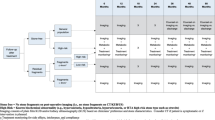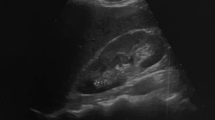Abstract
Purpose
We assessed the change in remaining kidney function after laparoscopic donor nephrectomy using serial technetium 99m diethylenetriaminepentaacetic acid (DTPA) scans and investigated the factors affecting the course.
Methods
Data from 155 donors were obtained from a prospectively maintained database. All donors underwent consecutive DTPA scans preoperatively and 1 month, 6 months and 1 year postoperatively. We investigated the longitudinal change in renal function after surgery and analyzed parameters to influence the perioperative glomerular filtration rate (GFR) change.
Results
The changes in GFR according to the DTPA scan presented significant improvement from 1 month up to 2 years after donation (all p < 0.001). The DTPA-GFR of the remaining kidney increased by 14.8 % to 58.2 ± 10.6 ml/min/1.73 m2 (p < 0.001) and by 33.9 % to 78.0 ± 14.0 ml/min/1.73 m2 at 1 month and 1 year after surgery, respectively (p < 0.001). Only 21.9 % of donors categorized into chronic kidney disease (CKD) stage 3 or more at 1 year after donation were <60 ml/min/1.73 m2 according to DTPA-GFR. Multivariate regression analysis revealed that the increase in DTPA-GFR at 1 year was negatively associated with patient age (p = 0.005), BMI (p = 0.04) and preoperative DTPA-GFR of remaining kidney (p = 0.009).
Conclusions
The DTPA-GFR of remaining kidney increased steadily for up to 2 years after surgery. Younger donors with lower body mass index and those with lower initial function of the remaining kidney demonstrated a greater increase in DTPA-GFR after nephrectomy. Many of the donors with CKD stage 3 after donation have good renal function according to the results of DTPA-GFR.


Similar content being viewed by others
References
Greco F, Hoda MR, Alcaraz A, Bachmann A, Hakenberg OW, Fornara P (2010) Laparoscopic living-donor nephrectomy: analysis of the existing literature. Eur Urol 58:498–509
Hadjianastassiou VG, Johnson RJ, Rudge CJ, Mamode N (2007) 2509 living donor nephrectomies, morbidity and mortality, including the UK introduction of laparoscopic donor surgery. Am J Transplant 7:2532–2537
Johnson EM, Remucal MJ, Gillingham KJ, Dahms RA, Najarian JS, Matas AJ (1997) Complications and risks of living donor nephrectomy. Transplantation 64:1124–1128
Najarian JS, Chavers BM, McHugh LE, Matas AJ (1992) 20 years or more of follow-up of living kidney donors. Lancet 340:807–810
Ibrahim HN, Foley R, Tan L, Rogers T, Bailey RF, Guo H, Gross CR, Matas AJ (2009) Long-term consequences of kidney donation. N Engl J Med 360:459–469
Ellison MD, McBride MA, Taranto SE, Delmonico FL, Kauffman HM (2002) Living kidney donors in need of kidney transplants: a report from the organ procurement and transplantation network. Transplantation 74:1349–1351
Sommerer C, Morath C, Andrassy J, Zeier M (2004) The long-term consequences of living-related or unrelated kidney donation. Nephrol Dial Transplant 19(Suppl. 4):iv45–iv47
Garg AX, Muirhead N, Knoll G, Yang RC, Prasad GV, Thiessen-Philbrook H, Rosas-Arellano MP, Housawi A, Boudville N, Donor Nephrectomy Outcomes Research (DONOR) Network (2006) Proteinuria and reduced kidney function in living kidney donors: a systematic review, meta-analysis, and meta-regression. Kidney Int 70:1801–1810
Cuevas-Ramos D, Almeda-Valdés P, Arvizu M, Mata J, Morales-Buenrostro LE, Gabilondo B, Vilatobá M, Correa-Rotter R, Gabilondo-Navarro F, Mehta R, Aguilar-Salinas CA, Alberú J, Gómez-Pérez FJ (2011) Association of the metabolicsyndrome and long-term renal function in kidney donors. Transplant Proc 43:1601–1606
Barlow AD, Taylor AH, Elwell R, Buttress AS, Moorhouse J, Nicholson ML (2010) The performance of three estimates of glomerular filtration rate before and after live donornephrectomy. Transpl Int 23:417–423
Issa N, Meyer KH, Arrigain S, Choure G, Fatica RA, Nurko S, Stephany BR, Poggio ED (2008) Evaluation of creatinine-based estimates of glomerular filtration rate in a large cohort of living kidney donors. Transplantation 86:223–230
Rule AD, Gussak HM, Pond GR, Bergstralh EJ, Stegall MD, Cosio FG, Larson TS (2004) Measured and estimated GFR in healthy potential kidney donors. Am J Kidney Dis 43:112–119
Cho HJ, Lee JY, Kim JC, Kim SW, Hwang TK, Hong SH (2012) How safe and effective is routine left hand-assisted laparoscopic donor nephrectomy with multiple renal arteries? A high-volume, single-center experience. Transplant Proc 44:2913–2917
Cho HJ, Choi YS, Bae WJ, Bae JH, Hong SH, Lee JY, Kim SW, Hwang TK, Cho YH (2013) Another option for laparoscopic living donor nephrectomy: a single center experience comparing two-port versus hand-assisted technique. J Endourol 27:587–591
Russell CD, Bischoff PG, Rowell KL, Kontzen F, Lloyd LK, Tauxe WN, Dubovsky EV (1983) Quality control of Tc99 m DTPA for measurement of glomerular filtration: concise communication. J Nucl Med 24:722–727
Yildiz B, Kural N, Colak O, Ak I, Akcar N (2008) IGF-1, IGFBP-3, VEGF and MMP-9 levels and their potential relationship with renal functions in patients with compensatory renal growth. Clin Physiol Funct Imaging 28:107–112
Ziada G, Youseif H, Khalil M (2009) Compensatory changes in the function of the remaining kidney immediately after unilateral nephrectomy in sheep. Tohoku J Exp Med 219:165–168
Chen Z, Fang J, Li G, Zhang L, Xu L, Pan G, Ma J, Qi H (2012) Compensatory changes in the retained kidney after nephrectomy in a living related donor. Transplant Proc 44:2901–2905
Song T, Fu L, Huang Z, He S, Zhao R, Lin T, Wei Q (2014) Change in renal parenchymal volume in living kidney transplant donors. Int Urol Nephrol 46:743–747
Choi KH, Yang SC, Joo DJ, Kim MS, Kim YS, Kim SI, Han WK (2012) Clinical assessment of renal function stabilization after living donor nephrectomy. Transplant Proc 44:2906–2909
Conflict of interest
The authors have no conflicts of interest to declare.
Ethical standard
The study was approved by the Institutional Review Board of Seoul St. Mary’s Hospital; informed consent was obtained from all patients.
Author information
Authors and Affiliations
Corresponding author
Rights and permissions
About this article
Cite this article
Cho, H.J., Choi, S.W., Bae, W.J. et al. Change in renal function following laparoscopic donor nephrectomy using 99 mTc-diethylenetriaminepentaacetic acid scan. World J Urol 33, 719–723 (2015). https://doi.org/10.1007/s00345-014-1408-0
Received:
Accepted:
Published:
Issue Date:
DOI: https://doi.org/10.1007/s00345-014-1408-0




